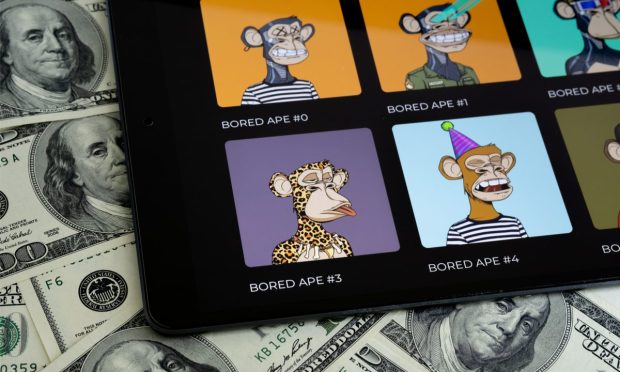The NFT Bubble Is Deflating – Will a Better User Experience Save It?

It’s tempting to take the U.K.’s announcement that it’s going to mint an NFT to signal the launch of new crypto policy as a sign that nonfungible tokens aren’t cool anymore. Sort of like how your mother getting a Facebook account marked the end of the social media giant’s edgy status.
In other words, it means awareness of the unique cryptocurrency tokens that can hold and track the provenance of media like art, video, music has gone mainstream.
See also: PYMNTS NFT Series: What Are NFTs and Why Are They Crypto’s Newest ‘Next Big Thing?’
Which isn’t the same thing as saying the market is taking off.
There are, it seems, more than a few signs that the market is deflating: The sales volume of collectable avatar NFTs led by Bored Ape Yacht Club (BAYC) and CryptoPunks collapsed in February after roaring into 2022 with a huge sales spike. And the number of daily sales has also dropped precipitously, from a high of more than 48,000 in mid-January to under 10,000 by mid-February, according to market tracker NonFungible.
See more: NFT Marketplace OpenSea Sees Sales Volume Drop 50% in First Week of September
Then again, the broader NFT market never really heated back up after surging wildly last summer, and it now rarely cracks 10% of the 150,000 to nearly 200,000 being traded back then. And if you look at the history of all NFTs, you’ll see a very similar spike.
Read more: PYMNTS DeFi Series: How to Buy an NFT in 19 Easy Steps
And even this market decline may be artificially inflated.
In January, CryptoSlam yanked $8 billion out of its NFT sales volume figures, citing what it called rampant wash trading at the No. 2 NFT marketplace, LookRare — although there’s an argument to be made that the users who are trading expensive NFTs back and forth among wallets they own are doing it for the site’s LOOKS tokens, which are given out as rewards, rather than intentional market manipulation.
Bubble or UX Trouble?
In early March, the Financial Times suggested the “great NFT sell-off” was a sign that the speculative frenzy was over. Even OpenSea, far and away the largest NFT market by sales and trading volume, has slumped.
So, is this a tulip bubble? Well, probably not. For one thing, all you can do with a tulip is put it in a vase for a few weeks. The attention NFTs have gotten in mainstream media and on social media may focus on the extremes — Bored Apes are still selling for more than a quarter-million dollars — which is deflating as the number of people with the desire and resources to buy one shrinks.
But there are a lot more uses coming for NFTs than what amounts to collectable art — whether it’s a seven-figure, 8-bit picture of a CryptoPunk or a new project by Jeff Koons, the world’s top-selling living artist.
See more: Jeff Koons’ Art Is Headed to the Moon but Will NFT Buyers Follow?
Record labels and independent artists are seeing the NFT as a better, less-forgeable medium to sell music on. Brands from Gucci to McDonald’s are embracing them as the metaverse gold rush picks up speed — despite the notable lack of much actual metaverse for taking in all of the virtual experiential marketing.
See more: Visa Creator Program Educates Artists on NFT Market
There’s another answer that’s probably better than a deflating bubble or return to sanity for why the NFT market is collapsing as the medium takes off: It’s too hard, and too expensive, to make and trade NFTs.
NFTs are mostly built on the Ethereum blockchain — although alternatives are appearing — which can make minting them pricey. And OpenSea charges a 2.5% fee, which could factor into the deflation of the market for expensive NFTs.
Also read: OpenSea Teams with MoonPay for NFT Credit Card Payments
But more to the point, the ability to buy and sell NFTs with credit cards rather than crypto is just starting to take off, marking the removal of a big hurdle. And soon you’ll be able to stow your NFTs on Instagram rather than figuring out how to find and use a digital cryptocurrency wallet.
